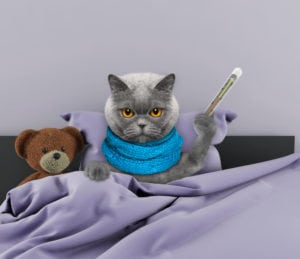Bladder Troubles!

Capi is a 4 year old neutered male cat. Capi’s owner noticed that he was hiding more and not wanting to eat or drink anything. When she saw him straining and crying out in the litter box, she brought Capi in to Temperance Animal Hospital for an exam to see if he was having trouble urinating or defecating. Capi was brought to our treatment area immediately for assessment by one of our Technicians. His bladder was noted to be about the size of a softball and firm. Unfortunately, Capi’s urinary bladder was blocked, which is a life-threatening emergency.
A urinary blockage occurs when tiny urinary crystals/stones, inflammation, or a mucus plug obstruct the urethra. It is more common in male cats due to how narrow their urethra is. Frustratingly, we don’t always know why this plug forms in some cats. We do know however that once it happens; they are at a higher risk of it happening again. There are several factors that play a role in urinary blockage including diet, infection, lack of water intake, and stress.
Since urination rids the body of toxins from the cat’s normal processes, when the urethra is obstructed toxins build up in the bloodstream and the kidneys can become damaged, making them sick. Once a cat is blocked, they can become so critically ill that they can die in as little as 48 hours if the obstruction is not relieved. Capi was admitted to the hospital and the process of getting him unblocked began. We collected a blood sample to look for electrolyte imbalances and assess the kidney values for damage. Capi’s potassium was low and his kidney enzymes (BUN and Creatinine) were both slightly elevated. Both changes are common in blocked cats. Support for the kidneys was provided by IV fluids with added potassium. Sometimes we also recommend taking an x-ray of the abdomen to look for urinary stones in the bladder.
Relieving a urinary blockage involves passing a semi-rigid catheter to dislodge the obstruction and allow the bladder to empty. As the bladder empties we collect a sample of the urine to perform diagnostic tests. In the urine we look for crystals which can form stones, bacteria, blood, protein, and many other things to help us assess any damage to the urinary system. Capi had Struvite crystals which may stick together and form varying sizes of stones. He also had blood, bacteria, and protein in the urine; all common findings when there is inflammation and damage to the urinary system. Using the catheter we flush the bladder with sterile fluid until it clears. Then we replace this catheter with one that is more flexible and suture it into place for the next few days. This catheter remains in place because the blockage, pressure, and unblocking process have caused inflammation to the urethra. Without something holding the urethra open, it is at risk of spasming and swelling so much that urine can’t get through again causing a re-blockage. Another common cause of re-blockage is further crystal production.
Capi stayed with us for three days after being unblocked. During this time he was on IV fluids, had his urine output monitored, and was started on a new diet and medications. The Prescription Diet he was switched to is specially formulated to dissolve Struvite stones and stop new crystals (Struvite and Calcium Oxalate) from forming. This will minimize the risk for Capi having future blockages. Often pets that have multiple blockages are switched to a similar diet and will remain on it for the rest of their lives to reduce the risk of further issues.
Twenty four hours after the unblocking procedure, we rechecked Capi’s blood work. His potassium was back within normal ranges and his kidney values had already returned to normal. Capi was lucky since this is not always the case and some cats will need to be managed for ongoing renal insufficiency. Even with these improvements, Capi didn’t get to go home until his urine returned to a normal volume and color again indicating a decrease in inflammation. Capi went home on his new food, pain medication and a medication to reduce spasms in the urethra.
There are many complications that can arise with Urinary Obstruction. One of these is an increased risk of blocking again. There isn’t always a trend on the time frame when this can happen. It may be in one week or many years after the initial episode. If urinary stones are present, the pet may need to have them surgically removed to decrease further complications. Finally, if a male cat blocks multiple times, surgical intervention may be necessary to stop this process from continuing to happen. The surgery is called a Penile Urethrostomy. This procedure involves reconstructing the urethral opening to be wider…more like a female cat. This wider opening doesn’t allow for material to accumulate as easily which decreases the risk of further blockages. This reconstructive surgery does not always solve the underlying bladder/urinary tract issue and ongoing treatment with diet and medications is still needed. The surgery simply helps to reduce the risk of the life-threatening obstructive episodes.
Fortunately, Capi did not have any stones and was able to avoid surgery. Since leaving the hospital last year he has not had any more urinary trouble and is enjoying his special diet!
